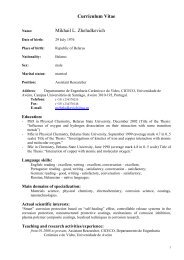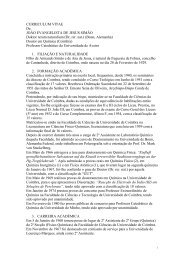XII Iberian Meeting of Electrochemistry XVI Meeting of the ...
XII Iberian Meeting of Electrochemistry XVI Meeting of the ...
XII Iberian Meeting of Electrochemistry XVI Meeting of the ...
You also want an ePaper? Increase the reach of your titles
YUMPU automatically turns print PDFs into web optimized ePapers that Google loves.
<strong>XII</strong> <strong>Iberian</strong> <strong>Meeting</strong> <strong>of</strong> <strong>Electrochemistry</strong> & <strong>XVI</strong> <strong>Meeting</strong> <strong>of</strong> <strong>the</strong> Portuguese Electrochemical Society PA 02<br />
Electrodegradation <strong>of</strong> 4-aminonaphtalene-1-sulfonic acid with<br />
BDD and Ti/Pt/PbO 2 Anodes<br />
A.S. Rodrigues, M.J. Pacheco, L. Ciríaco, A. Lopes<br />
UMTP and Department <strong>of</strong> Chemistry, University <strong>of</strong> Beira Interior, 6201-001 Covilhã, Portugal<br />
asfrodrigues@hotmail.com<br />
Naphthalene sulfonic amines are very toxic pollutants released to <strong>the</strong> environment in <strong>the</strong><br />
effluents <strong>of</strong> several industries, especially in <strong>the</strong> textile industry. Many <strong>of</strong> this type <strong>of</strong><br />
pollutants are biorefractory and electrochemical processes, such as anodic oxidation<br />
using anodes with high oxygen overpotential, like boron doped diamond (BDD) and<br />
Ti/Pt/PbO 2 , have become an alternative method to achieve <strong>the</strong>ir degradation [1]. Both<br />
anodes have high oxidation power and are able to generate highly reactive physisorbed<br />
hydroxyl radicals.<br />
The aim <strong>of</strong> this work was to study <strong>the</strong> performance <strong>of</strong> <strong>the</strong> above mentioned anodes,<br />
BDD and Ti/Pt/PbO 2 , in <strong>the</strong> anodic oxidation <strong>of</strong> 4-aminonaphtalene-1-sulfonic acid,<br />
using as supporting electrolyte two different salts: NaCl and Na 2 SO 4 .<br />
Ti/Pt/PbO 2 electrodes, with geometric area <strong>of</strong> 10 cm 2 , were prepared by <strong>the</strong>rmal<br />
electrochemical method [2]. The BDD electrode was purchased from Adamant<br />
Technologies/CSEM. The electrochemical assays were performed in galvanostatic<br />
mode, at 300 A m -2 imposed current density. The electrochemical assays were run in an<br />
electrochemical cell, with a BDD or Ti/Pt/PbO 2 anode, working in batch mode.<br />
Degradation <strong>of</strong> 4-aminonaphtalene-1-sulfonic acid was followed by UV-VIS<br />
spectrophotometry, Chemical Oxygen Demand (COD) and Total Organic Carbon (TOC)<br />
determinations.<br />
When <strong>the</strong> performance <strong>of</strong> both anode materials is compared, in <strong>the</strong> tests run with NaCl<br />
as electrolyte, it can be concluded that <strong>the</strong> mineralization is always higher for <strong>the</strong> BDD<br />
anode, since after 6 h assay TOC removal was 61% for this electrode and 21% for <strong>the</strong><br />
Ti/Pt/PbO 2 . However, in what concerns COD removals, <strong>the</strong> difference between <strong>the</strong><br />
<br />
BDD and 90% for those performed with Ti/Pt/PbO 2 .<br />
The analysis <strong>of</strong> data obtained with chlorides suggest that COD removal occurs in <strong>the</strong><br />
first hours <strong>of</strong> electrolysis, while, with sulfates, removal occurs gradually throughout <strong>the</strong><br />
test. In spite <strong>of</strong> this different behavior, <strong>the</strong> final COD removal, after 6 h, is only slightly<br />
dependent on <strong>the</strong> electrolyte.<br />
Acknowledgments: The financial support <strong>of</strong> Fundação para a Ciência e a Tecnologia, F CT, BII-<br />
12/UMTP/UBI/2009.<br />
References<br />
[1] Ciríaco L.; Anjo C.; Correia J.; Pacheco M.J.; Lopes A. Electrochimica Acta, 2009, 54, 1464.<br />
[2] Andrade L.S.; Rutuolo L.A.M.; Rocha-Filho R.C.; Bocchi N.; Biaggio S.R.; Iniesta J.; Garcia-<br />
Garcia V.; Montiel V. Chemosphere, 2007, 66, 2035.<br />
September, 811, 2010. ISEL - Lisbon 57








